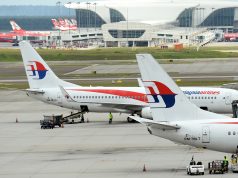Kuala Lumpur, Feb 26 – With Malaysia Airlines suffering RM1.2 billion worth of red ink in 2013, it might be extra difficult for the national carrier to properly evaluate how it should go about deciding its fleet replacement due in a few months.
Against such a scenario, it has to decide which aircraft manufacturer will give the best deal and which aircraft are best suited for its operations.
But difficult or not, it has to decide fast before the year runs out as it needs more modern and fuel efficient aircraft from as early as 2016 to stay in the hunt for strong market share or else choosy passengers may turn away to carriers with spanking new planes or that ageing aircraft may further push up operating costs.
For major carriers these days, the choice is either A or B — Airbus or Boeing.
Over the last few years, Malaysia Airlines has increasingly veered towards Airbus, especially with its flagship carrier, the double-deck A380 Superjumbo, which has higher capacity up to 525 passengers for long haul routes.
Malaysia Airlines has 88 aircraft in its fleet, operating Airbus A330s and A380s, and Boeing 777-200s and 737s.
The airline is now looking to replace its older A330s and Boeing 777-200s with A330s, A350-900s, A350-1000s, Boeing 787-10s or 737 Max in the medium to long term. Conservative estimates put the figure around 30 new aircraft but some have even suggested close to 100 new planes.
Deciding on aircraft purchases are not an easy matter as airline officials, and in Malaysia Airlines’ case, government officials, too, as the government owns a sizeable stake in the national carrier, would need to weigh in a lot of issues, including acquisition costs, fleet commonality for the air and ground crew to work efficiently, and things like spare parts.
Another important consideration is offset agreements, which essentially are agreements between two parties, whereby a supplier agrees to buy products from the party to whom it is selling, in order to win the buyer as a customer and offset the buyer’s purchase.
Alternatively, the amount of related investments poured into a certain industry and their spin-off effects are also carefully thought over.
In the case of Boeing, it has been aggressively pursuing opportunities spelt out in the 10th Malaysia Plan and taking advantage of the country’s high-tech labour force and aerospace manufacturing capability.
Analysts say that the government’s promotion of the aerospace parts manufacturing industry has led to Malaysia becoming a leader in South East Asia.
They say that the ability for the local industry to absorb complex work packages requiring a sophisticated labour force at a high volume has continued to attractinvestment and additional work packages from Boeing and its suppliers.
For Boeing, its investments and supply chain activities in Malaysia have become critical to its global supply chain as all commercial programmes include sourcing components and parts from Malaysia, industry observers point out.
All in all, Boeing has 14 suppliers in Malaysia supporting all its commercial aircraft programmes and such activity had contributed between US$325 million (about RM1.07 billion) and US$347 million (about RM1.14 billion) to the Malaysian economy since 2006.
Its major supplier is Aerospace Composites Malaysia (ACM) located at Bukit Kayu Hitam in Kedah. Currently owned by Boeing and Hexcel, it was formed in 1998 as a joint venture for composites fabrication and minor parts assembly.
Today, Boeing Commercial Airplanes is the end customer for nearly all of ACM s output in sophisticated wing parts and components.
In November 2013, ACM spent US$17 million (about RM56 million) to expand its factory space by 40 percent or 125,000 sq ft to 440,000 sq ft to support increased production by Boeing Commercial Airplanes for the Next-Generation B737, B747-8, B767, B777 and B787 Dreamliner.
The expansion by Boeing and Hexcel will allow ACM to grow its high-tech manufacturing workforce beyond its current 950 employees, furthering its position as the leading employer in Bukit Kayu Hitam.
Other Boeing’s key suppliers include Spirit Aerosystems Malaysia, which was established in 2007 and employs 500 people at its 300,000 sq ft facility in Subang to produce the B777 wing tips and B787 wing parts.
CTRM, located in Melaka, makes B787 Rolls Royce/General Electric fan cowlings or covers; SME Aerospace, located in Sungai Buloh, makes machine parts; Singapore Aerospace Manufacturing makes aluminium fan cases and engine beams in Penang while UPECA Technologies in Shah Alam and Imai Aero Equipment in Melaka are the other important parts suppliers to Boeing.
In the case of Airbus Industrie, it also buys parts from CTRM and Spirit Aerosystems Malaysia.
It has also announced plans to further develop its presence in Malaysia by expanding its joint-venture maintenance unit, Sepang Aircraft Engineering (SAE), and setting up new wholly-owned Airbus Customer Services Centre adjacent to the SAE facility at the KL International Airport in Sepang for Maintenance, Repair and Overhaul (MRO) jobs.
– Bernama











